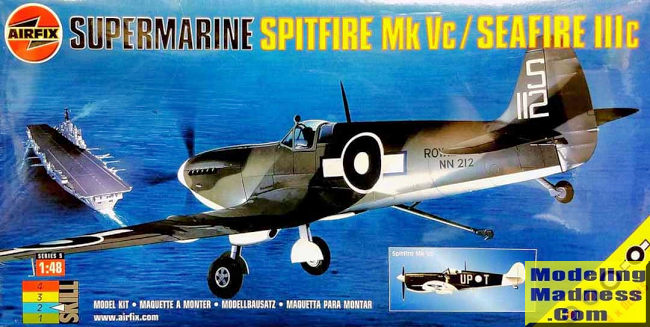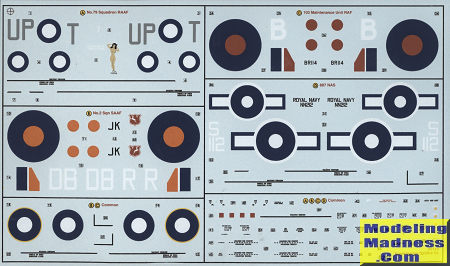
Airfix 1/48 Spitfire Vc/Seafire III
| KIT #: | 05110 |
| PRICE: | $ |
| DECALS: | Four options |
| REVIEWER: | Scott Van Aken |
| NOTES: | Mixture of old raised panel line kit with new engraved sprues. |

| HISTORY |
The Supermarine Seafire was a naval version of the Supermarine Spitfire adapted for operation from aircraft carriers. It was analogous in concept to the Hawker Sea Hurricane, a navalised version of the Spitfire's stablemate, the Hawker Hurricane. The name Seafire had been derived from the abbreviation of the longer name Sea Spitfire.
The Seafire F Mk III was the first true carrier adaptation of the Spitfire design. It was developed from the Seafire Mk IIC, but incorporated manually folding wings allowing more of these aircraft to be spotted on deck or in the hangars below. Supermarine devised a system of two straight chordwise folds; a break was introduced immediately outboard of the wheel-wells from which the wing hinged upwards and slightly angled towards the fuselage. A second hinge at each wingtip join allowed the tips to fold down (when the wings were folded the wingtips were folded outwards). This version used the more powerful Merlin 55 (F Mk III and FR Mk III) or Merlin 55M (L Mk III), driving the same four-bladed propeller unit used by the IIC series; the Merlin 55M was another version of the Merlin for maximum performance at low altitude. Other modifications that were made on the Spitfire made their way to the Seafire as well including a slim Aero-Vee air filter and six-stack ejector type exhausts. The shorter barrelled, lightweight Hispano Mk V cannon were introduced during production as were overload fuel tank fittings in the wings This Mark was built in larger numbers than any other Seafire variant; of the 1,220 manufactured Westland built 870 and Cunliffe Owen 350. In 1947 12 Mk IIIs were stripped of their naval equipment by Supermarine and delivered to the Irish Air Corps.
From 1942 onwards, the first operationally-viable Seafire F Mk III variant entered squadron service. This led to the type rapidly spreading throughout the FAA. In November 1942, the first combat use of the Seafire occurred during Operation Torch, the Allied landings in North Africa. In July 1943, the Seafire was used to provide air cover for the Allied invasion of Sicily; and reprised this role in September 1943 during the subsequent Allied invasion of Italy. During 1944, the type was again used in quantity to provide aerial support to Allied ground forces during the Normandy landings and Operation Dragoon in Southern France. During the latter half of 1944, the Seafire became a part of the aerial component of the British Pacific Fleet, where it quickly proved to be a capable interceptor against the feared kamikaze attacks by Japanese pilots which had become increasingly common during the final years of the Pacific War.
| THE KIT |
This kit was released in 2002, one of the last years prior to the most recent bankruptcies of the company and while still owned by Humbrol/Heller and their bean counters. Rather than do a proper kit, they took the cheap way out and tossed in three sprues from their ancient Spitfire V kit. These sprues have soft detail, raised panel lines and a goodly amount of flash on the well worn parts. From these sprues one uses the clear bits, fuselage halves, tailplanes (which have sink areas on them), and landing gear along with cockpit parts and the three blade Rotol prop. All the Seafire bits including new wings, four blade prop and tail hook assembly are on the new sprues.
These new wings have inserts for the cannon bulges and separate wing tips. You get extended tips for one of the markings option. In addition, you can two two or four cannon wings, though it doesn't tell you which option gets the four cannon. The new wings also means you get separate flaps, which is sort of odd as Spitfires and I assume Seafires were rarely seen with flaps lowered on the ground as they blocked proper cooling from the wing radiators. You are also provided a large sand filter for the desert markings options.
If doing the Seafire, you need to cut away a section of the lower fuselage for the A frame tail hook housing prior to joining the fuselage halves together. Wing fold lines will also need to be scribed into the wings. The instructions provide guidance for this. For some of the options wing gun openings will need to be filled as well.
 Instructions
are well done with the usual Humbrol paint numbers and no indication of just
what those colors might be so dig out your Humbrol charts to decipher this. Of
the four options, three are Spitfire Vc aircraft and only one is a Seafire III.
One Spit V is with 79 Squadron RAAF in green and light blue with white tail and
wing leading edges. The next two are in desert camo with the first being with 2
Squadron SAAF in Sicily, and the second with extended wing tips and most of the
gun openings filled with 103 MU in North Africa. The lone Seafire III is in
standard FAA colors with 877 Squadron on the HMS Indeftigable in the Pacific at
the end of the war. The large sheet is well printed and matte with a full
stencil suite.
Instructions
are well done with the usual Humbrol paint numbers and no indication of just
what those colors might be so dig out your Humbrol charts to decipher this. Of
the four options, three are Spitfire Vc aircraft and only one is a Seafire III.
One Spit V is with 79 Squadron RAAF in green and light blue with white tail and
wing leading edges. The next two are in desert camo with the first being with 2
Squadron SAAF in Sicily, and the second with extended wing tips and most of the
gun openings filled with 103 MU in North Africa. The lone Seafire III is in
standard FAA colors with 877 Squadron on the HMS Indeftigable in the Pacific at
the end of the war. The large sheet is well printed and matte with a full
stencil suite.
| CONCLUSIONS |
There you have it. I would have thought that Airfix would have added in the required engraved bits for this kit by now, but apparently that won't happen soon. It does make into a nice model, but the mixture of old and new parts is not the way to properly do a kit and sales suffered accordingly.
| REFERENCES |
https://en.wikipedia.org/wiki/Supermarine_Seafire
August 2019
Copyright ModelingMadness.com. All rights reserved.
If you would like your product reviewed fairly and fairly quickly, please contact the editor or see other details in the Note to Contributors.
Back to the Main Page Back to the Previews Index Page Back to the Review Index Page